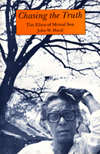In the book Chasing the Truth: The Films of Mrinal Sen, author John W. Hood provides an insightful examination of the sociopolitical and cultural conditions that have shaped filmmaker Mrinal Sen’s personal and creative ideology. Born into a middle-class Bengali family in Faridpur in 1923, Hood provides a contextual frame of reference to the independence movement in this rural area as a “hotbed of the stream of the Independence Movement that was non-Gandhian in that it was characteristically violent.” Sen’s father, a nationalist and politically active lawyer, had the reputation throughout his career of defending fellow nationalists whose allegiance to insurgent organizations made it impossible for them to receive a fair trial under the very colonial government that they had sought to overthrow. It is, therefore, not surprising that Sen’s politicization not only came at an early age, but would also deeply define his character (and that of his cinema) as well: a lifelong commitment to social causes that would be further galvanized with his involvement in the activism of the political left during his university days at the Scottish Church College in Calcutta. As Hood would later comment:
Mrinal Sen will always be regarded as a champion of lame ducks and underdogs. The Bengali poor – that vast majority of anonymity – perform a major role in many of his films, but never as heroes, only as victims. It will be remembered, of course, that Sen regards the notion of ‘the noble poor’ to be a perverse rationalization in favor of the status quo, and so in none of his films does he seek to idealize the masses in any way, portraying them rather in their material poverty, their ignorance, and most significantly, their powerlessness.
Hood also suggests that Sen’s films are integrally rooted in the culture of Calcutta, citing that the city – often associated with nefarious Western connotations of decay, chaos, and misery (in particular, through the conjured images of the Black Hole of Calcutta in which British soldiers were imprisoned in a dungeon in 1756, Winston Churchill’s missive during his stay in the region in which he comments “I shall always be glad to have seen it – namely that it will be unnecessary for me ever to see it again”, and in the works of Mother Theresa in which the city has become inextricably associated with images of abject poverty) – instead provides a constant source of intellectual, philosophical, political, and social stimulation for the filmmaker through its natural state of constant flux and re-invention.
Sen’s screen essay [Calcutta: My El Dorado] is sufficient to regard Calcutta itself as harbouring contradiction: wealth and poverty, splendour and squalor, pre-industrial and post-industrial economy, artistry and scholarship and disorder and ignorance, vibrant optimism and morbid pessimism. The really significant paradox is Calcutta’s constant decay and its constant regeneration. The flood comes, the city survives, the floodwaters recede, the city, rejuvenated, springs back to life. No sooner to the police scatter the huts of the pavement dwellers than they are built again…For Chaitanya to cherish the man who dies every day, he must also be born every day.
It is this awareness of perpetual transformation that not only provides the creative stimulus for Sen’s filmmaking, but also becomes an integral part of his narrative philosophy:
‘Death’ might seem surprising as a metaphor for the constant flow of the stream of history, being so obviously a mark of finality. In Indian thinking, however, death is one side of a coin in which birth is the other…While Mrinal Sen is a rationalist and by no means a religious Hindu, he does belong to a culture which readily accepts the notion of time as cyclic. An end of something is always the beginning of something else; hence, ‘death’, can be a useful metaphor for change and movement in the ebb and flow of history.
In essence, this cycle of renewal has also contributed to a characteristic, thematic open-endedness in Sen’s films, from the literal and metaphoric dawning of a new day after the family experiences an economic and interpersonal crisis following the disappearance of their sole wage-earner, their unmarried (and callously exploited) daughter Chinu in Ek Din Pratidin, to the unreconciled departure of the photographer from the decaying mansion in Khandahar after a brief connection with the beautiful Jamini whose devotion to her ailing mother has bound her to a life of isolation and enabling illusion, and also the existential crossroads between civilization and autonomous existence of Genesis as a figurative Garden of Eden is destroyed by jealousy, rivalry, and greed.
© Acquarello 2005. All rights reserved.
